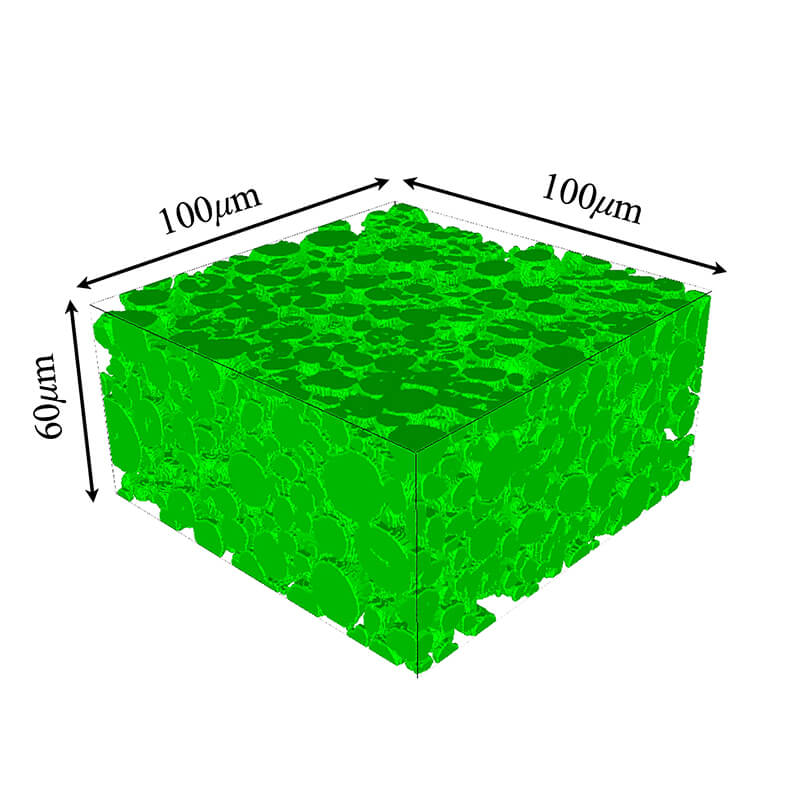April 24, 2017
‘Data-driven’ design could lead to improved lithium-ion batteries
 Advanced multi-scale modeling and simulations will be used to guide experiments in a project funded by the Toyota Research Institute to improve rechargeable lithium-ion batteries for electric and hybrid vehicles. In this 3-D rendering, the green spheres represent individual battery particles. This image was published in "Validity of the Bruggeman relation for porous electrodes" D.-W. Chung, M. Ebner, D. R Ely, V. Wood, and R E. García. Modelling and Simulation in Materials Science and Engineering, Volume 21:074009, 2013. (Purdue University image/ Tony Chung)
Download image
Advanced multi-scale modeling and simulations will be used to guide experiments in a project funded by the Toyota Research Institute to improve rechargeable lithium-ion batteries for electric and hybrid vehicles. In this 3-D rendering, the green spheres represent individual battery particles. This image was published in "Validity of the Bruggeman relation for porous electrodes" D.-W. Chung, M. Ebner, D. R Ely, V. Wood, and R E. García. Modelling and Simulation in Materials Science and Engineering, Volume 21:074009, 2013. (Purdue University image/ Tony Chung)
Download image
WEST LAFAYETTE, Ind. — Purdue University is working with MIT and Stanford University in a project funded by the Toyota Research Institute to improve rechargeable lithium-ion batteries and accelerate their integration into electric and hybrid vehicles.
Purdue’s part of the four-year effort is to better understand the fundamental science governing how a battery’s internal architecture impacts energy storage, recharging speed and reliability, said Edwin García, a Purdue professor of materials engineering.
Advanced multi-scale modeling and simulations will be used to guide experiments aimed at improving the design of electrodes called cathodes and anodes, which contain particles made of emerging materials such as lithium iron phosphate or lithium cobalt oxide.
While the Purdue researchers will focus on theory, they will collaborate with their Stanford and MIT counterparts to guide the design of experiments based on insights from modeling. Data from the experiments will then, in turn, be used for input and validation to refine modeling, with the ultimate goal of solving key limitations in today’s rechargeable batteries.
“This work is data-driven, and we want to learn how the nano-scale structure affects a material’s macro-scale behavior and overall battery performance,” García said. “We will use data to come up with better models and to better understand the basic science of materials at the atomic scale.”
The porous electrodes must contain just the right density and design of particles for optimal performance and diffusion of lithium ions, which are contained in an electrolyte liquid or gel.
“Using the analogy of chocolate chip cookies, the chips are the battery particles, which contain the energy, and the dough represents the space between particles,” he said. “You can’t have too few or too many chips, so there is a sweet spot there that you are aiming for.”
The three universities are sharing $10 million as part of a $35 million initiative by Toyota. The project began in early April.
“It’s very unusual for a project funded by industry to span four years and support theoretical research, so you have to give Toyota credit for its dedication to solving this problem,” García said. “This is an opportunity to develop the necessary fundamental scientific foundation to correlate materials’ chemistry, properties and performance and unravel the complexity in existing and emerging battery materials.”
Researchers will observe the changing microscopic details of the particles as a battery charges and discharges.
The project will involve two Purdue graduate students.
“They will be directly involved with experimentalists at Stanford and MIT, actually influencing the design of the experiments, and for modeling students that’s very unusual,” García said. “That’s a huge gain intellectually for the students.”
Writer: Emil Venere, 765-494-4709, venere@purdue.edu
Source: R. Edwin Garcia, 765-494-0148, redwing@purdue.edu

